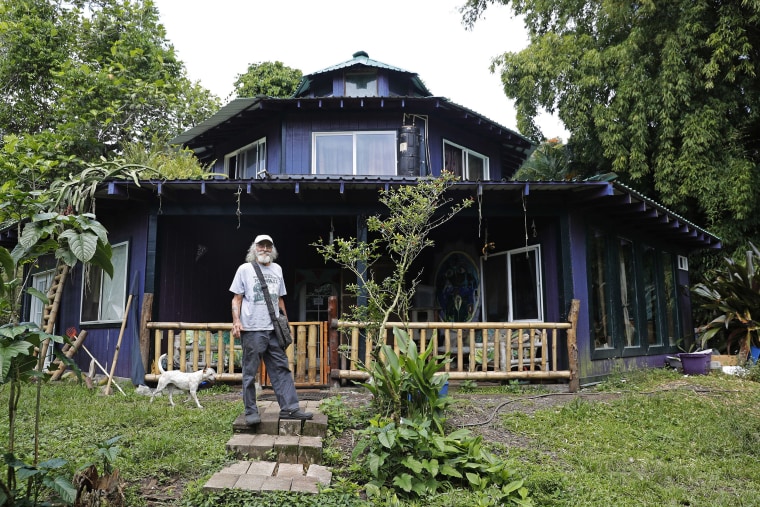There is an increased chance of explosive eruptions from the Kilauea volcano in Hawaii that could shoot rocks for miles and bring ashfall covering potentially dozens of miles, the U.S. Geological Survey said Wednesday.
The steady lowering of a lava lake at the summit of the volcano has increased the potential for explosive eruptions in the coming weeks, the USGS said in a statement. If the lava column dropped to the level of groundwater beneath Kilauea's caldera, a massive volcanic crater, an influx of water could cause "steam-driven explosions," the statement said.
Those explosions could shoot pebble-size rocks over several miles and larger ones for up to half a mile, the USGS said. The larger rocks could weigh a few pounds to several tons.
Minor ashfall could also occur up to several dozen miles from the area.
"At this time, we cannot say with certainty that explosive activity will occur, how large the explosions could be, or how long such explosive activity could continue," the statement said.
Police went door-to-door in Hawaii late Tuesday to roust residents near two new vents emitting dangerous gases in areas where lava has been pouring into streets and backyards for the past week.
Authorities ordered nearly 2,000 residents to leave two communities in the mostly rural district of Puna on Hawaii's Big Island last Thursday. Some ignored the order and stayed to watch over their property.
But on Tuesday, the emergence of the two new vents prompted Hawaii County to issue a cellphone alert ordering stragglers in Lanipuna Gardens to get out immediately. Police followed up with personal visits.
"There were a number of people at their residences," Talmadge Magno, the administrator for Hawaii County Civil Defense, said at a news briefing. There was no sign of holdouts in Lanipuna afterward, he said.
Edwin Montoya, 76, had planned to stay to care for animals and keep looters away from his family's property in neighboring Leilani Estates. But he was forced to evacuate after the new fissures emerged, including one just a mile away.
"I'm in my truck right now on my way up the road," he said. "The police came down here and made me."

A river of red has turned into a sea of smoldering molten rock, blocking the only road to Raylene Lerum's home.
"You don't feel right. You can't sleep, you can't eat," she told NBC News. "It's almost like you could feel the lava flowing under you."
One resident, Julie Leialoha, told NBC News that she feels "sorry for my neighbors up the road there, it's bad. It's really bad."
Leilani Estates and Lanipuna Gardens are both in a forested, remote part of the Big Island on the eastern flank of the Kilauea volcano, which has been erupting continuously since 1983.
In recent years, the volcano has mostly released lava in hard-to-reach areas inside a national park or along the coastline. But last week, vents popped open and released lava, gas and steam inside residential neighborhoods.
There's no indication when the eruption might stop, or how far the lava might spread.
There were about 1,700 residents in Leilani Estates and a few hundred in Lanipuna Gardens before last week.
Andrew Nisbet evacuated last week and has no idea what has happened since.
"My home is right in the line of the major breakouts so maybe, maybe not." he said Monday during a community meeting.
Authorities urged Scott Wiggers to evacuate, but he refused.
"I'm in the safest part in the subdivision. There's no threat to my house whatsoever," said Wiggers, a tour guide.

Wiggers said he wasn't leaving his home on the outskirts of the evacuation zone because he worried that if he did, he wouldn't be able to get back in. But he's prepared in case the situation takes a turn.
"I am packed. My truck is loaded. I'm not a dum-dum. If I see a threat, I'm out of here," he said.
Officials warn that lava could flow downhill and burn areas that are not currently in danger, and that toxic volcanic gas could kill people, especially the elderly and those with breathing problems.
Gov. David Ige told evacuees that he has called the White House and the Federal Emergency Management Agency to tell officials that the state will need help to deal with the volcano on the Big Island.
There are 14 lava- and gas-producing fissures in Leilani Estates, after the two new ones formed Tuesday. But the flow of lava is not constant.
A total of 36 structures, including 26 confirmed homes, have been destroyed. Aerial surveys cannot make out whether some of the structures are homes or other types of buildings.
